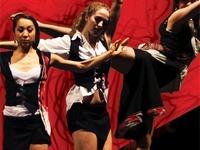A bare stage is the birthplace of a dancer’s art—a space where emptiness is the presence preceding emergence, the incubator for stories narrated through movement. On a particular Thursday night, seven members of the Harvard Ballet Company mill about the Loeb Mainstage; with a few preparatory jumps, they gauge the pliancy of the marley floor before beginning rehearsal of a piece from the Company’s latest production, “Momentum.”
Turning his back to five hundred empty seats that will be filled this time next week, choreographer David F. “Ricky” Kuperman ’11 calls out instructions as the dancers mark individual movements and walk through formations. When Kuperman requests a full-out execution of a few eight-counts, the dancers unveil a spectacular range of movement, collectively brushing through a front “attitude” position into a stag leap and “chasse” effortlessly into two diagonal lines.
They work on fragments of Kuperman’s piece for an hour; Elizabeth C. Walker ‘11—one of the show’s directors and a performer—has a “cabriole” injected into her step sequence to smooth out a transition, while standardizing arm movements are added to an ensemble segment. Kuperman stops Kevin Shee ’11 to give him a pointer on the artistic delivery of his solo entrance: “This needs to be so grounded—like a mummy coming to life. Everything starts in the core of the body.” Shee follows Kuperman’s example, inhaling sharply to incorporate the tense, almost convulsive movement into his body language.
As the rehearsal hits its midpoint, Kuperman’s conclusion that “the main critique is that you’re too pretty,” draws a laughing assent from the dancers. After all, this dance does deviate from classically beautiful performances like Petipa’s “Giselle” and Balanchine’s “Diamonds”; like all six pieces programmed for “Momentum”—which will run from Nov. 6 to 14—it is an experiment in fusing the traditional with the contemporary, the familiar with the unknown, and the sure-fire audience pleaser with the black-horse hit. HBC’s production, though created in the hours between classes, aims to push beyond the mediocrity of convention towards an ambitious, innovative vision. As a student group undertaking, “Momentum” is reflective of how far Harvard dance has been able to come despite being an extracurricular program, but it also displays the limits HBC will continue to face until it becomes a full-fledged endeavor.
UP HIGH
Over the past 10 years, the Harvard ballet program has become one of the strongest among Ivy League schools, according to dance director Elizabeth Bergmann. During her tenure, a number of Dramatic Arts courses have been added, more and more accomplished performers have been visiting as guest artists, and in 2005, the Harvard Dance Center opened.
“I danced in the Program and with HBC when I was a grad student in ’03, and there is a palpable difference in the Harvard dance scene now,” assistant dance director Kristin Ing Aune writes in an email. “While the Dance Program has always attracted talented dancers, we have increased visibility for a number of reasons: our accomplished graduate-ambassadors, performances, roster of guest artists, the Task Force on the Arts, the internet, word of mouth... dance is alive and well at Harvard.”
The notable improvement of the Dance Program has attracted an increasing number of talented students, many of whom join HBC. Its current membership includes dancers who trained for nearly a decade at the School of American Ballet (the New York City Ballet’s feeder training academy), others who performed on national tours with professional dance companies, and a contestant on “So You Think You Can Dance Canada.”
“A lot of these students come highly trained,” Bergmann says. “In their form ballet, some of them are really, really good. Some of them are exceptional. Some of them were professional dancers before they came to Harvard.”
A roster of this caliber enables HBC to accomplish what many other student dance groups do not; supported by professional coaching and workshops with leaders on the Boston dance scene and beyond, HBC aspires to and is able to achieve world-class performance standards.
THE MAIN DRAG
HBC conceived “Momentum” as an eclectic, high-level dance production demonstrating the potential and direction of 21st century dance months ago, when it considered staging a follow-up to its 2006 showcase of 20th century dance, “American Grace.” Members immediately identified the Loeb Mainstage, home to the American Reperatory Theater and the largest theater space available on campus, as the Company’s ideal performance venue.
Since three student productions are selected to grace the Mainstage each year, the Company had to complete a rigorous application process—which included a 50-page document detailing the vision and merits of the show—to secure the space. Met with success, “Momentum” is now one of only four dance productions in Mainstage history, the last of which—“American Grace”—was three years ago.
HBC then proceeded to recruit a host of choreographers and dancers of an artistic caliber befitting the Mainstage’s prestige. Walker and co-director Merritt Moore ’11 commissioned professional choreographer Josie Walsh, whose work blending commercial dance with ballet and circus arts has electrified the Los Angeles dance scene, to create an original piece for the company.
“We were looking for [someone with] an interdisciplinary, forward-looking approach to dance, and Josie was really the perfect person,” Walker says. Walsh’s piece promises an extravaganza of movement that combines the daring technique of a Cirque de Soleil production, the throbbing musical energy of a rock concert, and the exhilarating drive of a hip-hop battle.
Read more in Arts
It Ain’t Always Sunny in Boston: Films Lie About City















